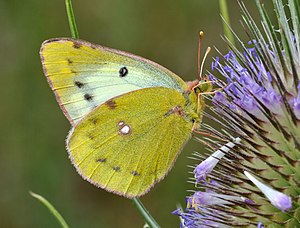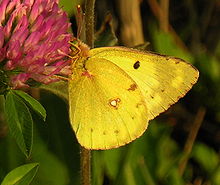Golden eight
| Golden eight | ||||||||||||
|---|---|---|---|---|---|---|---|---|---|---|---|---|

Golden Eight ( Colias hyale ), female |
||||||||||||
| Systematics | ||||||||||||
|
||||||||||||
| Scientific name | ||||||||||||
| Colias hyale | ||||||||||||
| ( Linnaeus , 1758) |
The Golden Eight , also Posthörnchen , Small Posthörnchen , White Clover Gelbling , Common Yellow Ling , Yellow Clouded Yellow or Common Clouded Yellow ( Colias hyale ), is a butterfly ( hiking moth ) from the family of Whites (Pieridae) in the subfamily of the yellow pieces . The specific epithet is derived from a forest nymph from Greek mythology . The species , which is very variable in appearance and size, avoids hot areas and occurs from Western Europe to China.
It was named Butterfly of the Year 2017 by the BUND environmental foundation.
features
Characteristics of the adults
In Europe, the male moths have a wingspan of 35 to 40 mm and a yellow base color. The females have a wingspan of 38 to 42 mm and a yellow-white basic color, only the tip of the fore wings and the hind wings are yellowish on the underside. The upper side of the wing of both sexes has a dusted dark brown to black band at the edge, whereby this is only narrow on the hind wings. In the cell of the forewings there is a black spot on the top and bottom. The males have an orange spot with a red border on the upper side of the hind wings in the cell, on the underside this spot is brightly and more clearly bordered in red. This spot can be divided into two by the red border so that it resembles an eight, similar to other yellowlings of the genus Colias . In females, the orange spot on the upper side of the hind wings is not bordered. Colias hyales is quite variable in its large area of distribution and Verhulst describes over 100 forms .
Characteristics of the caterpillars
The caterpillars of the Golden Eight differ significantly from the caterpillars of the yellow horseshoe clover ( Colias alfacariensis ) after the second moult . Both caterpillars are green, but the caterpillar of the yellow horseshoe clover has four conspicuous yellow lines with black dots, while the caterpillar of the golden eight has only two thin, green-yellow side lines with orange-brown stripes. The caterpillar of the Golden Eight can hardly be distinguished from the caterpillar of the postilion ( Colias crocea ).
The caterpillars overwinter and pupate in the following spring as a greenish-yellow belt pupa .
Subspecies
- Colias hyale alta Staudinger , 1886. With a wingspan of 36 to 44 mm in the male and 40 to 46 mm in the female, this subspecies is significantly larger than one of the other known subspecies. It lives in forest clearings and in alpine areas at an altitude of 2500 to 3600 meters, with it being the most common up to 2900 meters. Occurrences are found in Kyrgyzstan in the Alai Mountains and in Tajikistan in the Ghissar Mountains , where they fly in August and September. Staudinger describes the males as follows:
- “... with a very wide black apex and outer edge of the forewings in which there is a more or less wide row of yellow spots. The hind wings have a fairly wide black outer edge, before the inward usually still a more or less complete black spot number is ... On the hind wings enters the gray pollination front of the inside edge on so strong as very rare in hyale other localities exceptionally the case is. "
- The status of the subspecies is not clear and is considered by some authors to be a separate species Colias alta .
- Colias hyale palidis Fruhstorfer , 1910. This subspecies is a rather small subspecies with a wingspan of 34 to 40 mm in the male and 32 to 44 mm in the female. The moths have a pale greenish-yellow base color, a dull gray apical spot on the forewing and a small discal point. The black outer edge is missing on the hind wings. The species has been identified in Russia, Kazakhstan and China and flies from July / August to September / October, depending on the region.
Similar species
The golden eight ( Colias hyale ) forms a species complex together with the horseshoe-clover yellow ( Colias alfacariensis ). Since the moths of both species develop many variations, the two species cannot be differentiated either habitually or on the basis of a genital examination . Information about the habitat and the geographical distribution only provides an indication of which of the two species it may be. A reliable distinction is only possible using the completely different habitually caterpillars.
- Horseshoe clover ( Colias alfacariensis )
- Postillon ( Colias croceus )
- Alpine yellow fling ( Colias phicomone )
- High Moor Gelbling ( Colias palaeno )
- Colias erate
distribution
The Golden Eight is common in Europe from eastern Spain to northern China. Because the moths avoid hot areas, they are absent in the Mediterranean and South Asia. In northern Germany and the Netherlands they are not found every year. Occasionally they immigrate to England and southern Scandinavia. The vertical distribution ranges from sea level to over 2000 meters.
Habitat
The Golden Eight flies in the entire used and unused cultural landscape over open terrain, especially over meadows with clover and alfalfa , over orchards , wet meadows and poor and dry grassland . Meadows and pastures, fallow land , ruderal terrain and poor grassland (especially juniper heather ) are preferred for laying eggs .
Way of life
The caterpillar of the Golden Eight lives on Kronwicke , various clovers ( red clover , white clover , stone clover , horseshoe vetch , black medic , trefoil ), several species of vetch ( Vicia hirsuta , Vicia tetrasperma , bird vetch ) and alfalfa , to which the female also lays the eggs. Often times the female will sit on the ground and curve her abdomen forward to glue an egg to the top of the leaf of a small, puny plant.
The moths fly violet in summer and yellow in autumn (including alfalfa, brook thistle , meadow knapweed , field scabious , oregano (Dost), hawkweed , adder's head ).
The Golden Eight flies in two generations in May / June and August / September or in three generations from May to October. The first-generation caterpillars live in September and can be found in April after overwintering. The second generation larvae can be observed from June to July.
supporting documents
literature
- LG Higgins, ND Riley: The Butterflies of Europe and Northwest Africa . Paul Parey Publishing House, Hamburg and Berlin 1970, ISBN 3-490-02418-4 .
- Manfred Koch : We determine butterflies. Volume 1: Butterfly. 4th enlarged edition. Neumann, Radebeul / Berlin 1966, DNB 457244224 .
- Butterfly I (knight butterfly (Papilionidae), whitefly (Pieridae), noble butterfly (Nymphalidae)) . In: Günter Ebert, Erwin Rennwald (eds.): The butterflies of Baden-Württemberg . tape 1 . Ulmer Verlag, Stuttgart 1993, ISBN 3-8001-3451-9 .
- Joseph T. Verhulst: Les Colias du Globe . 1 (texts - text). Goecke and Evers, Keltern 2000, ISBN 3-931374-15-7 .
- Josef Grieshuber, Gerardo Lamas: A Synonymic List of the Genus Colias FABRICIUS, 1807 (Lepidoptera: Pieridae) . Ed .: Communications of the Munich Entomological Society. tape 97 , October 31, 2007, ISSN 0340-4943 , p. 131-171 ( PDF ).
Individual evidence
- ^ Colias in Societas Entomologica , 10th year, 1895/96. Retrieved June 5, 2013.
- ↑ Karl Mazzucco, Wanderflug der Butterflies (PDF; 718 kB), p. 56, in: Communications from the Natural Science Working Group House of Nature, Salzburg 1 approx. 1951/52. Retrieved June 5, 2013.
- ↑ Eckstein, The Butterflies of Germany ( Memento of the original from April 26, 2016 in the Internet Archive ) Info: The archive link was automatically inserted and not yet checked. Please check the original and archive link according to the instructions and then remove this notice. (PDF; 15.5 MB), p. 59, KG Lutz 'Verlag 1913. Retrieved on June 5, 2013.
- ^ Colias in The Butterflies of Europe , Stuttgart 1908. Retrieved June 5, 2013.
- ^ Arnold Spuler: The butterflies of Europe . tape 1 . E. Schweitzerbartsche Verlagbuchhandlung, Stuttgart 1908, p. 9 .
- ↑ www.bund-nrw-naturschutzstiftung.de: Butterfly of the year 2017: "Goldene Acht" (accessed November 24, 2016)
- ↑ Higgins, Riley, pp. 54-56
- ↑ Verhulst, p. 43
- ↑ Grieshuber, p. 165
- ↑ Verhulst, pp. 43–44
- ↑ Grieshuber, p. 150
- ↑ www.lepiforum.de : Artkomplex Colias hyale (LINNAEUS, 1758) and C. alfacariensis RIBBE, 1905 , accessed on August 25, 2006
- ↑ Verhulst, p. 40
- ↑ Ebert, pp. 248-249
- ↑ Ebert, p. 251
- ↑ Ebert, p. 253
- ↑ Manfred Koch, Wolfgang Heinicke: We determine butterflies. 3. Edition. Neumann, Radebeul 1991, ISBN 3-7402-0092-8 .
Remarks
- ↑ The subspecies is described by Verhulst as Colias hyale irkutskana Stauder , 1923 and Colias hyale novasinensis Reissinger , 1989. Grieshuber & Lamas summarize the subspecies irkutskana , novasinensis and khingana under Colias hyale palidis Dubatolov & Streltzov , 2005 on the grounds of 'new subjective synonym '.
Web links
- Caterpillar at Lepiforum e. V. Taxonomy and Photos
- www.schmetterling-raupe.de
- Species profile at Science4you
- Natural history information system
- Colias hyale at Fauna Europaea



